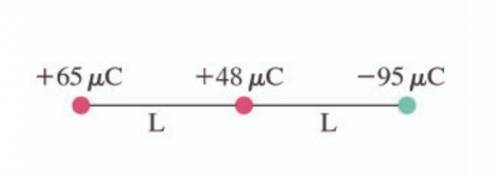
Physics, 14.04.2020 03:45 EssiePooh7649
Particles of charge +65, +48, and −95 μC are placed in a line (Figure 1). The center one is L = 35 cm from each of the others.
1) Calculate the net force on the left charge due to the other two. Enter a positive value if the force is directed to the right and a negative value if the force is directed to the left.
2) Calculate the net force on the center charge due to the other two. Enter a positive value if the force is directed to the right and a negative value if the force is directed to the left.
3) Calculate the net force on the right charge due to the other two. Enter a positive value if the force is directed to the right and a negative value if the force is directed to the left.


Answers: 3


Another question on Physics

Physics, 21.06.2019 13:40
Niobium forms a substitutional solid solution with vanadium. compute the number of niobium atoms per cubic centimeter for a niobium-vanadium alloy that contains 24 wt% nb and 76 wt% v. the densities of pure niobium and vanadium are 8.57 and 6.10 g/cm3, respectively
Answers: 1

Physics, 21.06.2019 16:50
Identify the arrows that show the correct direction of heat transfer. 66°f 112°f 98°f
Answers: 2


Physics, 22.06.2019 08:40
An isolated conducting spherical shell carries a positive charge. part a which statement (or statements) about the electric field and the electric potential inside and outside the spherical shell is correct? which statement (or statements) about the electric field and the electric potential inside and outside the spherical shell is correct? electric potential inside the shell is constant and outside the shell is changing as 1/r2 both the electric potential and the electric field does change with r inside and outside the spherical shell electric potential inside and outside the shell is constant, but not zero electric potential inside the shell is constant and outside the shell is equal to zero electric field inside and outside the shell is constant (does not change with the position r), but is not equal to zero electric field inside and outside the shell is changing as 1/r (where r is the distance from the center of the sphere) electric field inside is equal to zero and outside the shell is constant, but not zero electric potential inside the shell is constant and outside the shell is changing as 1/r electric field inside and outside the shell is changing as 1/r2 electric field inside is equal to zero and outside the shell is changing as 1/r2 electric field inside and outside the shell is zero electric field inside is constant and outside the shell is changing as 1/r
Answers: 3
You know the right answer?
Particles of charge +65, +48, and −95 μC are placed in a line (Figure 1). The center one is L = 35 c...
Questions

Computers and Technology, 20.08.2020 03:01

Computers and Technology, 20.08.2020 03:01


Mathematics, 20.08.2020 03:01




Social Studies, 20.08.2020 03:01


Computers and Technology, 20.08.2020 03:01


English, 20.08.2020 03:01






Mathematics, 20.08.2020 03:01




